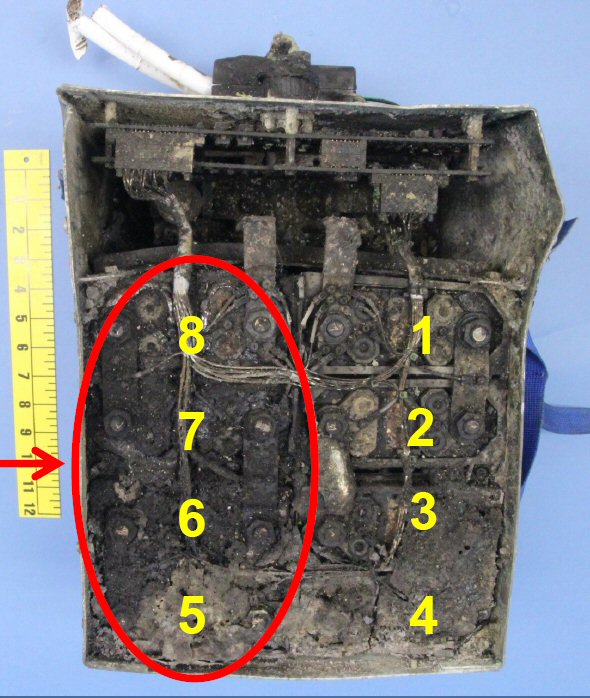LENR, Dendrites and Perhaps Dreamliner Battery Fires

Feb. 12, 2013 – By Steven B. Krivit –
The Boeing 787 Dreamliner lithium-ion battery fire mystery remains unsolved. But the remote yet possible cause – that a low-energy nuclear reaction (LENR) triggered the failure – just got more likely.
On Feb. 11, the Wall Street Journal reported that “investigators are examining whether the formation of microscopic structures known as dendrites inside the Boeing Co 787’s lithium-ion batteries played a role in twin incidents that prompted the fleet to be grounded nearly a month ago.”
In a July 16, 2010, document, Lewis Larsen, co-developer of the Widom-Larsen LENR theory, explained the possible relationship between lithium-ion battery fires, LENRs, and dendrites:
About 18 months ago, based on the W-L theory, [Allen Widom and I] conjectured that (a) LENRs might occur in high electric fields created by nanoscale lightning rod effects in discharge arcs (that is, electrical shorts) emanating from nm-to micron-scale lithium metal dendrites that grow inside Li-ion batteries and that (b) rapid (~10 -200 nanoseconds) multi-Watt heat-energy releases from nm to micron-scale LENR-active patches could provide a triggering mechanism for some subset of lithium-ion battery failures and fires. (Source document)
On Jan. 17, 2013, New Energy Times wrote “Are Nuclear Reactions Causing Boeing Dreamliner Battery Fires?” in which we explained the striking similarities between lithium-ion batteries and a conventional LENR experiment.
On Jan. 23, 2013, Larsen released another document on the potential relationship between LENRs and the recent lithium-ion battery fires.
On Feb. 7, Deborah A.P. Hersman, chairman of the National Transportation Safety Board, released a slide presentation that gave an update on the Jan 7, 2013, battery fire in the Japan Airlines B-787.

NTSB determined that the fire started in cell No. 6 of this unit within the JAL Boeing 787.
On Feb. 11, Larsen released a document with more details about LENRs as a possible trigger. He wrote that these rare lithium-ion battery fires include the conditions in which a LENR nano-fireball mechanism could serve as a proximate cause for runaway thermal events in these batteries.
Larsen’s July 16, 2010, slide presentation gives the basic concepts:
Here is what may actually be happening inside some subset of failing Li-ion batteries:
High electric fields in the vicinity of nanoscale dendrites create heavy-mass e* electrons, which then react with nearby protons, creating ultra-low-momentum (ULM) neutrons. ULM neutrons then capture on nearby lithium atoms in a LENR-l ithium reaction, causing micron-scale and smaller hot spots to occur on the surface of a Li dendrite.
Importantly, 5,000+ K temperatures inside a tiny LENR hot spot can vaporize an immediately adjacent volume of battery material into a tiny ball of hot plasma. Among other things, conductive ions in the hot plasma would start shorting out nearby battery microstructures.
Worse yet, such intense heat can liberate free oxygen from any nearby oxides (that is, Li2FePO4 found in battery cathodes); the oxygen then reacts with any lithium metal present, starting an internal oxygen-fueled lithium fire. If too many L ENR hot-spot events were to occur nearly simultaneously, it could trigger an unstoppable cascading runaway of exothermic chemical reactions that could damage or ruin a battery or entire battery pack through severe overheating.
In worst-case events, where Li-ion batteries explode, they would NOT be LENR explosions per se. An intense nanoscale nuclear energy release simply superheats a tiny region inside a battery which, in turn, triggers an escalating cascade of prosaic chemical oxidation reactions.
This situation is analogous to what happens when the sharp sound (acoustic energy) of a single gunshot can trigger a huge avalanche of snow that engulfs an entire side of a mountain. In this fashion (which might occur episodically), large multi-cell Li-ion battery packs used in vehicles could ignite and be destroyed by thermal fratricide.
Larsen’s Feb. 11, 2013, document provides additional perspective:
In my view, depending heavily on their exact location inside a battery and composition of nearby materials, … LENRs could serve as an extraordinarily hot match with local temperatures that are high enough to be capable of directly initiating even more exothermic metal-oxidation reactions that burn much hotter than a flammable electrolyte fire.
Unfortunately, such thermite-like pyrotechnic chemical reactions with metals can be nearly impossible to extinguish because they can generate their own oxygen through dissociation while an advancing flame front combusts battery materials that are inside a casing.
In my opinion, that’s where the safety danger lies with possible LENR-triggered thermal runaways. LENRs may be a rare Black Swan battery event, but a rather deadly one. Hence, on-board battery systems installed on human-passenger-carrying vehicles such as aircraft and submersibles should be designed with mitigation of this newly recognized type of safety risk.
[Feb. 16 News Update: Wall Street Journal reports “Airbus to Drop Lithium-Ion Batteries From Newest Jet” ]
Questions? Comments? Submit a Letter to the Editor.

